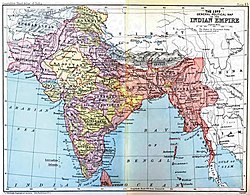Princely states

Imperial entities of India
|
|
| Dutch India | 1605–1825 |
|---|---|
| Danish India | 1620–1869 |
| French India | 1769–1954 |
|
|
|
| Casa da Índia | 1434–1833 |
| Portuguese East India Company | 1628–1633 |
|
|
|
| East India Company | 1612–1757 |
| Company rule in India | 1757–1858 |
| British Raj | 1858–1947 |
| British rule in Burma | 1824–1948 |
| Princely states | 1721–1949 |
| Partition of India |
1947
|
|
|
|
A princely state, also called native state (legally, under the British) or Indian state (for those states on the subcontinent), was a nominally sovereign monarchy under a local or regional ruler in a subsidiary alliance with a greater power. Though the history of the princely states of the subcontinent dates from at least the classical period of Indian history, the predominant usage of the term princely state specifically refers to a semi-sovereign principality on the Indian subcontinent during the British Raj that was not directly governed by the British, but rather by a local ruler, subject to a form of indirect rule on some matters; similar political entities also existed on or in the region of the Arabian Peninsula, in Africa and in Malaya, and which were similarly recognised under British rule, subject to a subsidiary alliance and the suzerainty or paramountcy of the British Crown. Oman, Zanzibar and the Trucial States were also under the Viceroy of India, and were administered by their rulers in the same manner as the Indian princely states, as part of the Persian Gulf Residency; they were officially categorised as British protectorates, with differing degrees of autonomy.
At the time of the British withdrawal, 565 princely states were officially recognised in the Indian subcontinent, apart from thousands of zamindaris and jagirs. The most prominent among those - roughly a quarter of the total - had the status of a salute state, one whose ruler was honoured by receiving a set number of gun salutes on ceremonial occasions, ranging from nine to 21. Rulers of salute states entitled to a gun salute of eleven guns and above received from the British the style of Highness; while the Nizam of Hyderabad had the unique style of Exalted Highness.
...
Wikipedia
